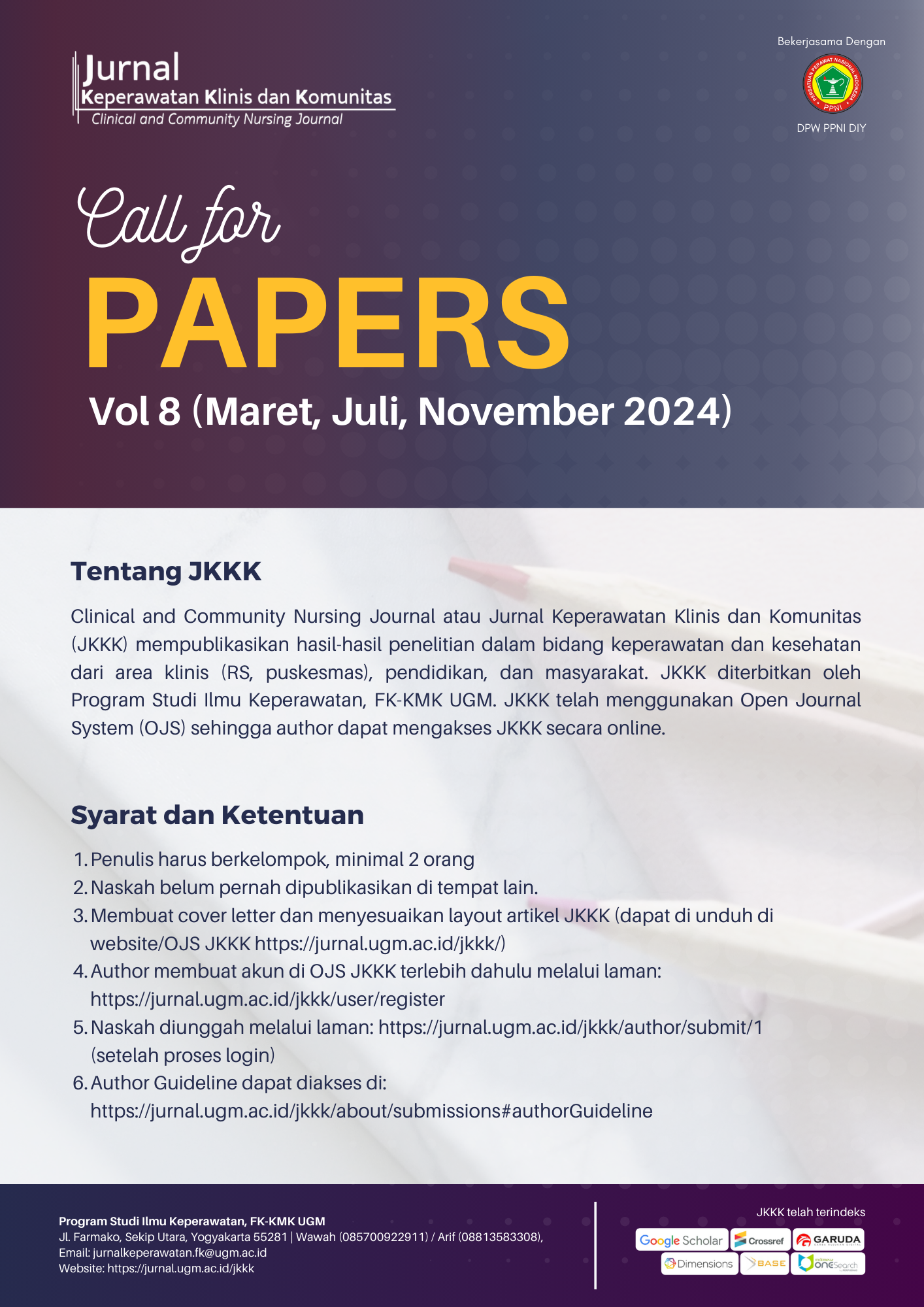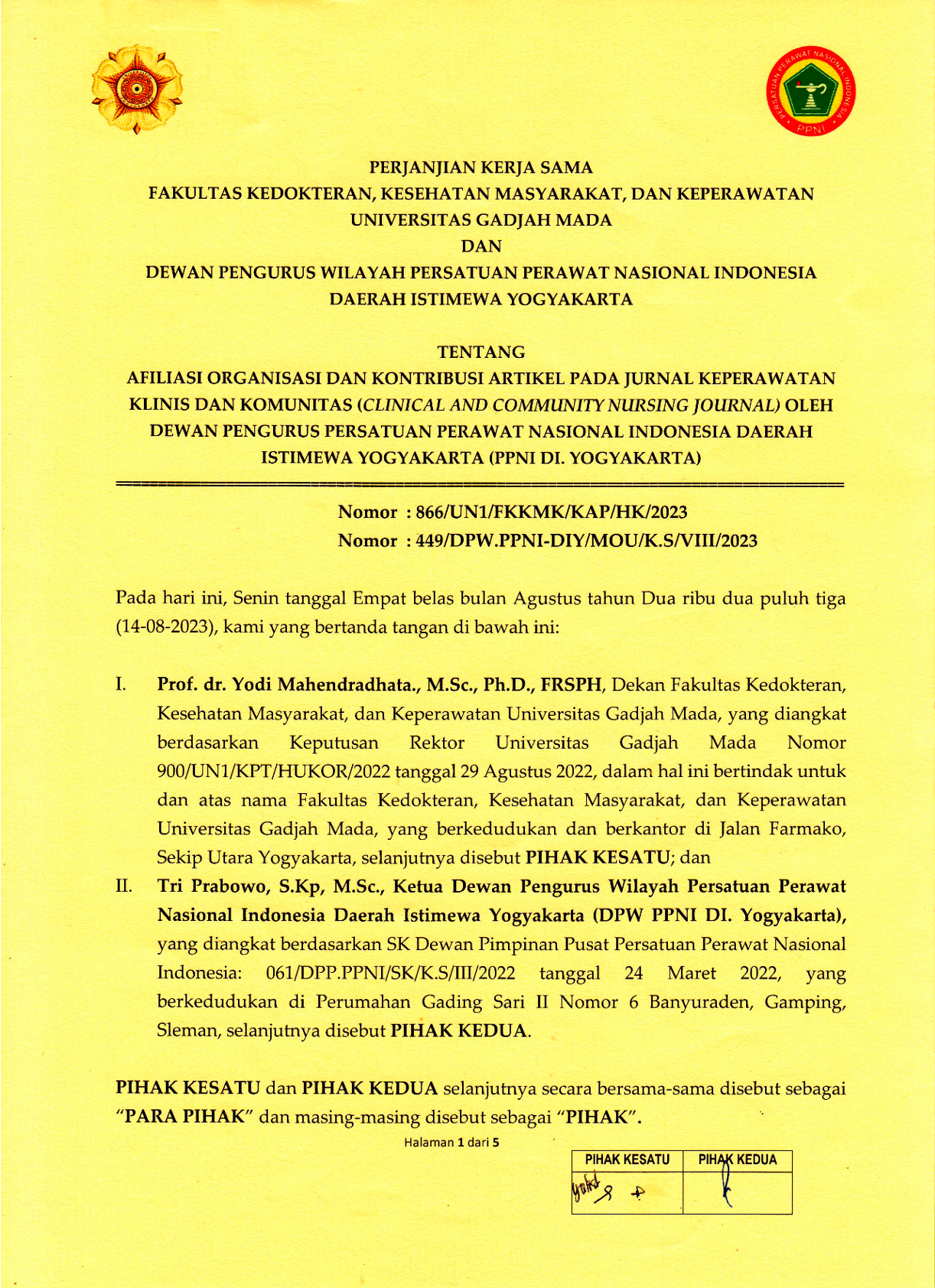Gambaran Tingkat Aktivitas Fisik Kelompok Risiko Tinggi Sindroma Metabolik di Wilayah Kerja Puskesmas Turi Kabupaten Sleman
Zenita Avisena(1*), Melyza Perdana(2)
(1) Program Studi Ilmu Keperawatan, Fakultas Kedokteran, Kesehatan Masyarakat, dan Keperawatan, Universitas Gadjah Mada
(2) Departemen Keperawatan Medikal Bedah Program Studi Ilmu Keperawatan Fakultas Kedokteran, Kesehatan Masyarakat dan Keperawatan Universitas Gadjah Mada
(*) Corresponding Author
Abstract
Background: The higher prevalence of metabolic syndrome in adults is linked to the risk factors associated with changes in lifestyle within a society. Each year, the level of physical inactivity within the community is increasing. Decreased levels of physical activity are strongly linked to the development of abdominal obesity, which is the main factor contributing to the incident of metabolic syndrome. The Turi region, which is classified as rural, has witnessed a steady rise in the cases of hypertension and type 2 diabetes. So it can be assumed that the risk of metabolic syndrome is likely to be high in this area.
Objective: The objective of this research is to find out the level of physical activity among people at a high risk for metabolic syndrome in the working area of Puskesmas Turi in Sleman Regency.
Method: This research was a descriptive quantitative research with the cross-sectional design. The subjects included in the study were those who were at a high risk of metabolic syndrome, in the working area of Puskesmas Turi in Sleman Regency. The respondents who participated were 87 in total that were chosen using consecutive sampling. The data retrieval process was using an IPAQ questionnaire to assess the level of physical activity. The data were analized using univariate analysis.
Result: The level of physical activity of the risk group for metabolic syndrome in the working area of the Puskesmas Turi, Sleman Regency, was classified into the category of moderate physical activity level (f=38, 43,7%), low physical activity level 28 people (32,2%), and 21 people (24,1%) in the high activity level category.
Conclusion: The majority of people at a high-risk of metabolic syndrome in Puskesmas Turi of Sleman Regency is in moderate physical activity.
Latar belakang: Prevalensi sindrom metabolik yang tinggi pada orang dewasa berkaitan dengan faktor risiko yang terkait dengan perubahan gaya hidup dalam masyarakat. Setiap tahun, tingkat inaktivitas fisik di masyarakat semakin meningkat. Penurunan tingkat aktivitas fisik sangat terkait dengan terjadinya obesitas perut, yang merupakan faktor utama penyebab terjadinya sindrom metabolik. Kecamatan Turi, yang diklasifikasikan sebagai pedesaan, mengalami peningkatan dari tahun ke tahun dalam kasus hipertensi dan diabetes tipe 2, sehingga dapat diasumsikan bahwa risiko sindrom metabolik cenderung tinggi di daerah ini.
Tujuan: Tujuan dari penelitian ini adalah untuk mengetahui tingkat aktivitas fisik pada kelompok berisiko tinggi sindrom metabolik di wilayah kerja Puskesmas Turi Kabupaten Sleman.
Metode: Penelitian ini merupakan penelitian deskriptif kuantitatif dengan desain cross sectional. Subjek dalam penelitian ini adalah mereka yang berisiko tinggi mengalami sindrom metabolik, di wilayah kerja Puskesmas Turi Kabupaten Sleman. Responden yang berpartisipasi berjumlah 87 orang dipilih secara consecutive sampling. Proses pengambilan data menggunakan kuesioner IPAQ untuk menilai tingkat aktivitas fisik. Data dianalisis dengan menggunakan analisis univariat.
Hasil: Tingkat aktivitas fisik yang dilakukan oleh kelompok risiko sindrom metabolik di wilayah kerja Puskesmas Turi Kabupaten Sleman tergolong dalam kategori tingkat aktivitas fisik sedang (n = 38, 43,7%), tingkat aktivitas fisik rendah 28 orang (32,2%), dan 21 orang (24,1%) pada kategori tingkat aktivitas tinggi.
Kesimpulan: Mayoritas penduduk yang berisiko tinggi mengalami sindroma metabolik di Puskesmas Turi Kabupaten Sleman berada pada tingkat aktivitas fisik sedang.
Keywords
Full Text:
PDFReferences
- Katzmarzyk PT, Lee IM. Sedentary behaviour and life expectancy in the USA: a cause-deleted life table analysis. BMJ open. 2012; 2(4):1–8. http://www.pubmedcentral.nih.gov/articlerender.fcgi?artid=3400064
- &tool=pmcentrez&rendertype=abstract
- Kementerian Kesehatan RI. Laporan Hasil Riset Kesehatan Dasar Indonesia (Riskesdas). Jakarta: Kementrian Kesehatan RI; 2013.
- Kementerian Kesehatan Republik Indonesia. Laporan Hasil Riset Kesehatan Dasar Provinsi Daerah Istimewa Yogyakarta (Riskesdas DIY). Jakarta: Kementerian Kesehatan RI; 2013.
- Esmailnasab N, Moradi G, Delaveri A. Risk Factors of Non-Communicable Diseases and Metabolic. 2012: 41(7); 77–85.
- Chen X, Pang Z & Li K. Dietary Fat, Sedentary Behaviors and the Prevalence of the Metabolic Syndrome Among Qingdao Adults. Nutrition, metabolism, and cardiovascular diseases : NMCD. 2009;19(1):27–34. http://www.ncbi.nlm.nih.gov/pubmed/18472251.
- Sinclair, Kaimi A,Buchwald, Dedra, Bogart, Andy, Henderson, Jeffrey A. The Prevalence of Metabolic Syndrome and Associated Risk Factors in Northern Plains and Southwest American Indians. Diabetes Care. 2011; 34(1): 118–120.
- World Health Organization. Noncommunicable Diseases Country Profiles [Internet]. c.2015 [updated 2014 cited 2015 Mar 7]. Available from: http://www.who.int/nmh/publications/ncd_profiles_report.pdf
- Bosak K. Managing Metabolic Syndrome: Focus on Physical Activity. The Journal for Nurse Practitioners. 2012; 8(3): 206–211. http://linkinghub.elsevier.com/retrieve/pii/S1555415511004259.
- Soewondo P, Purnamasari D, Oemardi M, Waspadji S, Soegondo S. Prevalence of metabolic syndrome using NCEP/ATP III criteria in Jakarta, Indonesia: the Jakarta primary non-communicable disease risk factors surveillance 2006. Acta Med Indones. 2010: 42(4); 199-203.
- Chu AHY & Moy FM. Journal of Science and Medicine in Sport Association between physical activity and metabolic syndrome among Malay adults in a developing country, Malaysia. Journal of Science and Medicine in Sport. 2014;17(2):195–200. Available at: http://dx.doi.org/10.1016/j.jsams.2013.04.003.
- Kementerian Kesehatan Republik Indonesia. Profil Kesehatan Indonesia 2013. Jakarta: Kementerian Kesehatan RI; 2014.
- Ford ES, Kohl HW 3rd, Mokdad AH, Ajani UA. Sedentary behavior, physical activity, and the metabolic syndrome among U.S. adults. Obes Res. 2005; 13(3): 608-14. http:/dx.doi.org/10.1038/oby.2005.65. PMID: 15833947.
- Dinas Kesehatan Kabupaten Sleman. Profil Puskesmas Turi Kabupaten Sleman. Sleman: Dinas Kesehatan Kabupaten Sleman; 2014.
- Moniruzzaman M, Zaman MM, Islalm MS, Ahasan HAMN, Kabir H, Yasmin R. Physical activity levels in Bangladeshi adults : results from STEPS survey 2010. Public Health. 2016;4–11. http://dx.doi.org/10.1016/j.puhe.2016.02.028.
- Caro J, Navarro I, Romero P, Priego MA, Martı´nez-Herva´ s S, Real JT, et al. Metabolic Effects of Regular Physical Exercise in Healthy Population. Endocri-nol Nutr. 2013; 60: 167–72.
- Kim J, Tanabe K, Yokoyama N, Zempo H, Kuno S. Association between physical activity and metabolic syndrome in middle-aged Japanese: a cross-sectional study. BMC Public Health. 2011; 11: 624. http://dx.doi.org/10.1186/ 1471-2458-11-624.
- Frugé AD, Byrd SH, Fountain BJ, Cossman JS, Schilling MW, Gerard P. Nutrition, Metabolism & Cardiovascular Diseases Increased physical activity may be more protective for metabolic syndrome than reduced caloric intake . An analysis of estimated energy balance in U . S . adults : 2007 e 2010 NHANES. Nutr Metab Cardiovasc Dis. 2015; 25(6): 535–40. http://dx.doi.org/10.1016/j.numecd.2015.
- 03.006.
- Hajian-Tilaki K, Heidari B. Association between Parity, Live Birth and the Risk of Obesity in Women. Int J Endocrinol Metab. 2007; 4: 109–18.
- Soewondo P, Purnamasari D, Oemardi M, Waspadji S, Soegondo S. Prevalence of Metabolic Syndrome Using NCEP/ATP III Criteria in Jakarta, Indonesia: The Jakarta Primary Non communicable Disease Risk Factors Surveillance 2006. Acta Med Indones-Indones J Intern Med. 2010; 42(4).
- Escobedo C, Schargrodsky H, Champagne B, Silva H, Boissonnet CP, Vinueza R, et al .Prevalence of the Metabolic Syndrome in Latin America and Its Assosiation With Sub-Clinical Carotied Atheroschlerosis: The CARMELA Cross Sectional Study Cardiovascular Diabetology. 2009; 852: 1-9
- Cornier MA, Dabelea D, Hernandez TL, Lindstrom LC, Steig AJ, Stob NR, et.al. The Metabolic Syndrome Endocrine Reviews. 2008; 29(7):777–822 .
- Lechleitner M. Obesity and Metabolic Syndrome in the Elderly: a Mini review. Gerontology. 2008; 54: 253-259.
- Wiklund P. The Role of Physical Activity and Exercise in Obesity and Weight Management : Time For Critical Appraisal. J Sport Heal Sci. 2016;10–3. http://dx.doi.org/10.1016/j.jshs.2016.04.001.
Article Metrics
Refbacks
- There are currently no refbacks.
Copyright (c) 2020 Zenita Avisena, Melyza Perdana

Jurnal Keperawatan Klinis dan Komunitas (Clinical and Community Nursing Journal)
collaborates with DPW PPNI DIY
![]()
Jurnal Keperawatan Klinis dan Komunitas (Clinical and Community Nursing Journal) is licensed under a Creative Commons Attribution-ShareAlike 4.0 International License.




